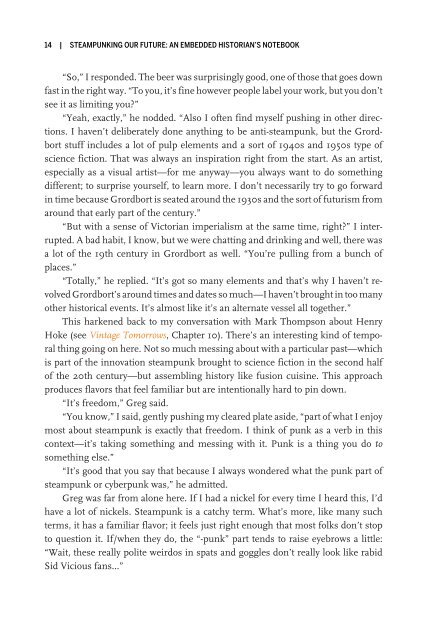Steampunking Our Future: An Embedded ... - cdn.oreilly.com
Steampunking Our Future: An Embedded ... - cdn.oreilly.com
Steampunking Our Future: An Embedded ... - cdn.oreilly.com
Create successful ePaper yourself
Turn your PDF publications into a flip-book with our unique Google optimized e-Paper software.
14 | STEAMPUNKING OUR FUTURE: AN EMBEDDED HISTORIAN’S NOTEBOOK<br />
“So,” I responded. The beer was surprisingly good, one of those that goes down<br />
fast in the right way. “To you, it’s fine however people label your work, but you don’t<br />
see it as limiting you?”<br />
“Yeah, exactly,” he nodded. “Also I often find myself pushing in other directions.<br />
I haven’t deliberately done anything to be anti-steampunk, but the Grordbort<br />
stuff includes a lot of pulp elements and a sort of 1940s and 1950s type of<br />
science fiction. That was always an inspiration right from the start. As an artist,<br />
especially as a visual artist—for me anyway—you always want to do something<br />
different; to surprise yourself, to learn more. I don’t necessarily try to go forward<br />
in time because Grordbort is seated around the 1930s and the sort of futurism from<br />
around that early part of the century.”<br />
“But with a sense of Victorian imperialism at the same time, right?” I interrupted.<br />
A bad habit, I know, but we were chatting and drinking and well, there was<br />
a lot of the 19th century in Grordbort as well. “You’re pulling from a bunch of<br />
places.”<br />
“Totally,” he replied. “It’s got so many elements and that’s why I haven’t revolved<br />
Grordbort’s around times and dates so much—I haven’t brought in too many<br />
other historical events. It’s almost like it’s an alternate vessel all together.”<br />
This harkened back to my conversation with Mark Thompson about Henry<br />
Hoke (see Vintage Tomorrows, Chapter 10). There’s an interesting kind of temporal<br />
thing going on here. Not so much messing about with a particular past—which<br />
is part of the innovation steampunk brought to science fiction in the second half<br />
of the 20th century—but assembling history like fusion cuisine. This approach<br />
produces flavors that feel familiar but are intentionally hard to pin down.<br />
“It’s freedom,” Greg said.<br />
“You know,” I said, gently pushing my cleared plate aside, “part of what I enjoy<br />
most about steampunk is exactly that freedom. I think of punk as a verb in this<br />
context—it’s taking something and messing with it. Punk is a thing you do to<br />
something else.”<br />
“It’s good that you say that because I always wondered what the punk part of<br />
steampunk or cyberpunk was,” he admitted.<br />
Greg was far from alone here. If I had a nickel for every time I heard this, I’d<br />
have a lot of nickels. Steampunk is a catchy term. What’s more, like many such<br />
terms, it has a familiar flavor; it feels just right enough that most folks don’t stop<br />
to question it. If/when they do, the “-punk” part tends to raise eyebrows a little:<br />
“Wait, these really polite weirdos in spats and goggles don’t really look like rabid<br />
Sid Vicious fans…”

















